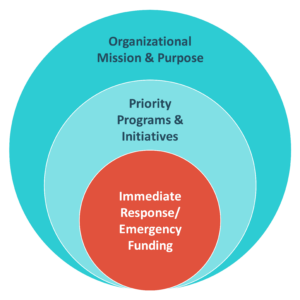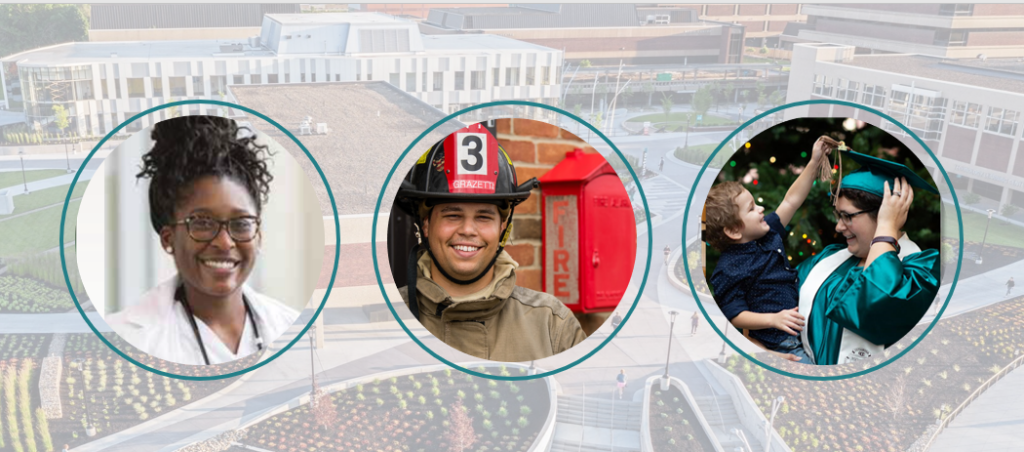Creating a rapid or immediate response fund is a regular practice for nonprofits looking to fulfill urgent and unmet financial needs. The initial stages of the COVID-19 pandemic created a surge in organizations establishing response funds. Now that we are half a year into the pandemic, calls for “immediate” COVID-19 response funding may be less urgent for your organization—and may also resonate less with donors.
There might be other emerging needs in the community that are now a priority for your organization. How can you adapt your response fund to address new funding areas and fit into your long-term development strategy?

The Mini Fundraising Campaign: Case, Leadership, Prospects, and Plan
Based on our experience helping numerous organizations navigate this situation, CCS offers a framework for organizational and fundraising leaders to think through refocusing fundraising efforts, while still communicating a clear and compelling story of your organization’s immediate needs. Thinking of your efforts like a mini fundraising campaign can be a useful technique for pivoting your response fund effectively.
Keep in mind that every fundraising initiative, from emergency/immediate response funds to capital or comprehensive campaigns, offers different funding opportunities that may appeal to different groups of supporters. The messaging for each funding area and audience warrants a customized and thoughtful approach.
1) Case for Support
Your case for support should clearly outline the need and discuss the priorities that a donor’s gift will support. It is important to understand why your organization is choosing to embark on this initiative now in order to share the sense of urgency with donors. If you are considering pivoting to a new funding focus area, allow the lessons you learned from the past six months to inform your messaging strategy.
Before (re)drafting your case for support, consider the following:
- How has the need for an emergency response fund or special appeal changed or evolved since the onset of the pandemic?
- Why now and why this initiative?
- What is the impact of one’s gift?
- What feedback did you receive from key supporters or volunteers on your initial case messaging? What resonated?
- Are there testimonials you can use to help tell your story?
2) Leadership
Engage board members, volunteers, and key community members to help tell your story. These advocates can share the immediate needs of your organization with those in their network and communicate the impact this effort can have on your organization and the greater community. Your board members can serve as key thought partners and lead any near-term efforts.
Consider leveraging your organization’s leadership network, both internal and external, to raise donor sights, accelerate the pace of giving, and inspire others to join. The idea that “generosity is contagious” has proven true even in these challenging times.
As you determine which community leaders to engage, consider the following:
- Who can be an advocate and champion for the case you are developing?
- Is there a matching gift challenge that you can establish for key volunteers and community leaders to engage in?
- What existing volunteers or community leaders can help be the voice for your campaign?
3) Prospects
Previous donors to your organization are always your best prospects. However, your current priorities or emerging needs might not appeal to your entire donor base. Think strategically on how the current case for support relates to different prospects. How might the needs of the organization mesh with a donor’s philanthropic interests?
It is important to ensure you are transparent with your donors and continuously steward the relationship to avoid donor fatigue. Continue to explore interests of your prospects through personal conversations. Use these exploratory conversations as an opportunity to test the case for support messaging.
Consider the following when building your prospect list:
- Are you communicating with donors outside of an ask?
- Are the prospective donors for this mini fundraising campaign the same or different from your initial immediate response fund prospects?
- Is there an opportunity to further segment your current donors to better fit this initiative?
- Are there links between this initiative and the last that may pique the interest of those same donors?
- Are there lapsed donors that have supported similar initiatives/focus areas that you could consider?
4) Plan
Now that your message is solidified, when and how should your organization shift its messaging and fundraising focus? It is important to build out a distinct project plan to achieve the fundraising goal you have set forth. Your plan should help prioritize aspects of your fundraising campaign, maintain momentum, and ensure your team is set up for success.
When developing your fundraising plan, consider the following:
- How long will this mini campaign last?
- Is there a specific goal to be set? Either participation or dollar based?
- What is your comprehensive communications plan?
- Is there a specific individual or group of people that can manage this effort?
- Have you received board or leadership buy-in before launching into this initiative?
- What creative ways can you increase awareness and engage the broader community?
- Video messages from leadership
- Matching gift challenges
- Testimonials
- Social media campaign
Case Study: Cuyahoga Community College (Tri-C)

CCS client partner Cuyahoga Community College (Tri-C) used the framework above to successfully guide and reposition their immediate assistance fund.
Tri-C is Ohio’s first community college and remains Ohio’s oldest and largest public community college. For more than 50 years, Tri-C has provided high quality, affordable education and training programs to more than 900,000 members of the community. Tri-C empowers students to complete their education in a timely manner and prepares students to prosper in the new global economy.
In March 2020, Tri-C recognized the deep impact the COVID-19 crisis was having on students’ personal lives. Accordingly, the college quickly focused their fundraising efforts on their Student Emergency Fund, which helped meet the immediate needs of students by providing resources and technology for successful remote learning. The Student Emergency Fund was established in 2017, but it received limited attention up until COVID-19 when donors began to understand how this fund was different from student scholarships.
The Fund received an overwhelmingly positive response from donors and community members. Tri-C engaged key volunteers and community members through Giving Tuesday Now and various matching gift challenges. As a result of tactics like these, the college was able to award more than $255,000 in student emergency funds. Moreover, through partnerships with community organizations like PCs for People, Tri-C distributed over 600 computers for at-home learning.
While providing virtual learning assistance for students remained an important charge as spring turned to summer, it became clear to Tri-C that amid the ongoing pandemic and social unrest in the country, their institution had the power to drive change and empower the community in a larger way.
Tri-C has since developed a new funding focus of enhancing and expanding the training that Tri-C offers to first responders to help them best serve the residents they’ve sworn to protect and care for. Student Emergency Fund and technology resources are still top of mind, but the key messaging has shifted. Tri-C’s current strategy is to reach out to key volunteers, community members, and donors to make a gift to support “Tri-C Responds” and the emerging immediate needs of Northeast Ohio. This new funding push resonates with the role Tri-C plays in being the “community’s college,” while meeting the immediate needs of the community, setting an example for what an equitable and inclusive community should look like, and ensuring that our future is better for all.
Conclusion
Tri-C is just one example of how organizations across the country that successfully implemented COVID-19 immediate response funds are now adapting their efforts to an evolving reality. When nonprofits consider how to pivot their fundraising efforts, it is important to ensure that the revised message speaks to the new and unique challenges that the community is facing in and outside of the pandemic.
In our 70-plus years of advising nonprofit institutions, CCS has observed that donors are eager to give when an organization makes an immediate commitment to the community that will have a long-term impact. Regardless of the unique situation you are facing, embrace the opportunity to shift your message or consider a new special appeal where appropriate. In an ever-changing world, your organizational priorities will likely continue to evolve. Evaluating your case, leadership, prospects, and plan will help keep your donors engaged through these shifts and beyond.
To access our full suite of perspectives, publications, and reports, visit our insights page and Strategies During COVID-19 resources page. To learn more about CCS Fundraising’s suite of services, click here.